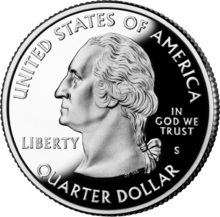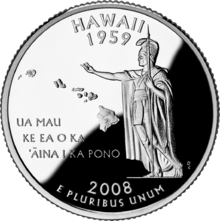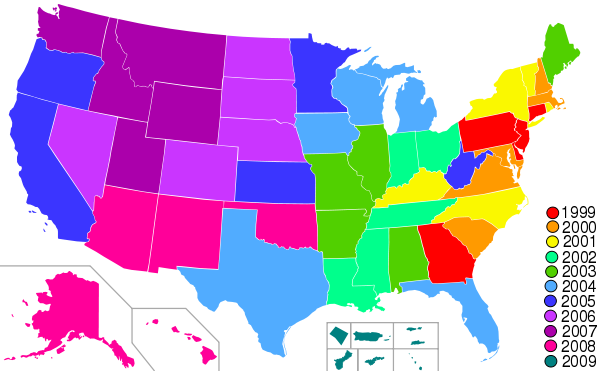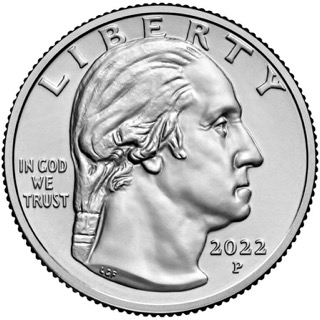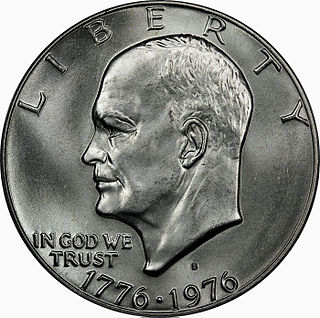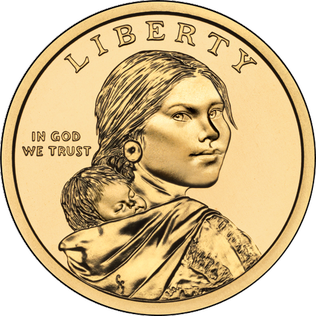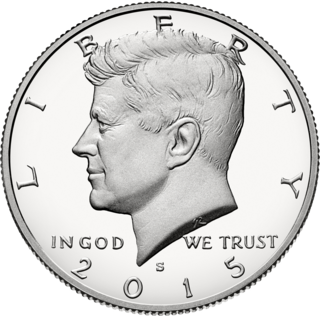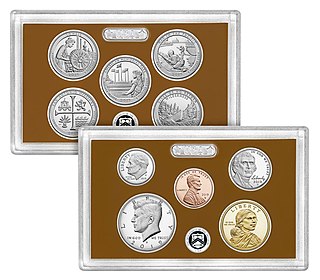| Year | No. | State | Release date
(statehood date) [15] | Mintage [16] | Design | Elements depicted | Engraver |
|---|
| 1999 | 1 | Delaware | January 4, 1999
(December 7, 1787) | 774,824,000 | 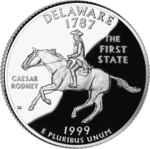 | Caesar Rodney on horseback
Captions: "The First State", "Caesar Rodney" | William Cousins |
| 2 | Pennsylvania | March 8, 1999
(December 12, 1787) | 707,332,000 |  | Commonwealth statue, state outline, keystone
Caption: "Virtue, Liberty, Independence" | John Mercanti |
| 3 | New Jersey | May 17, 1999
(December 18, 1787) | 662,228,000 |  | Washington Crossing the Delaware , which includes George Washington (standing) and James Monroe (holding the flag)
Caption: "Crossroads of the Revolution" | Alfred Maletsky |
| 4 | Georgia | July 19, 1999
(January 2, 1788) | 939,932,000 | 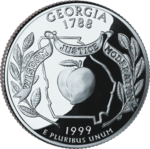 | Peach, live oak (state tree) sprigs, state outline
Banner with text: "Wisdom, Justice, Moderation" (the state motto) | T. James Ferrell |
| 5 | Connecticut | October 12, 1999
(January 9, 1788) | 1,346,624,000 | 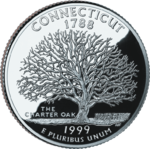 | Charter Oak
Caption: "The Charter Oak" | T. James Ferrell |
| 2000 | 6 | Massachusetts | January 3, 2000
(February 6, 1788) | 1,163,784,000 | 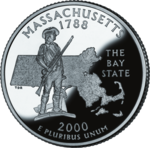 | The Minute Man statue, state outline
Caption: "The Bay State" | Thomas D. Rodgers |
| 7 | Maryland | March 13, 2000
(April 28, 1788) | 1,234,732,000 |  | Dome of the Maryland State House, white oak (state tree) clusters
Caption: "The Old Line State" | Thomas D. Rodgers |
| 8 | South Carolina | May 22, 2000
(May 23, 1788) | 1,308,784,000 |  | Carolina wren (state bird), yellow jessamine (state flower), cabbage palmetto (state tree), state outline
Caption: "The Palmetto State" | Thomas D. Rodgers |
| 9 | New Hampshire | August 7, 2000
(June 21, 1788) | 1,169,016,000 |  | Old Man of the Mountain, nine stars (representing New Hampshire as the 9th state to join the Union)
Captions: "Old Man of the Mountain", "Live Free or Die" | William Cousins |
| 10 | Virginia | October 16, 2000
(June 25, 1788) | 1,594,616,000 | 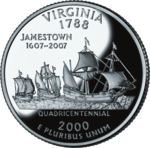 | Ships Susan Constant , Godspeed , Discovery
Captions: "Jamestown, 1607–2007", "Quadricentennial" | Edgar Z. Steever |
| 2001 | 11 | New York | January 2, 2001
(July 26, 1788) | 1,275,040,000 | 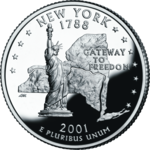 | Statue of Liberty, 11 stars (representing New York as the 11th state to join the Union), state outline with line tracing Hudson River and Erie Canal
Caption: "Gateway to Freedom" | Alfred Maletsky |
| 12 | North Carolina | March 12, 2001
(November 21, 1789) | 1,055,476,000 |  | Wright Flyer , John T. Daniels's iconic photo of the Wright brothers
Caption: "First Flight" | John Mercanti |
| 13 | Rhode Island | May 21, 2001
(May 29, 1790) | 870,100,000 |  | America's Cup yacht Reliance on Narragansett Bay, Claiborne Pell Newport Bridge
Caption: "The Ocean State" | Thomas D. Rodgers |
| 14 | Vermont | August 6, 2001
(March 4, 1791) | 882,804,000 |  | Maple trees with sap buckets, Camel's Hump Mountain
Caption: "Freedom and Unity" | T. James Ferrell |
| 15 | Kentucky | October 15, 2001
(June 1, 1792) | 723,564,000 |  | Thoroughbred racehorse behind fence, Bardstown mansion, Federal Hill
Caption: "My Old Kentucky Home" | T. James Ferrell |
| 2002 | 16 | Tennessee | January 2, 2002
(June 1, 1796) | 648,068,000 | 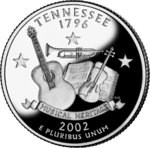 | Fiddle, trumpet, guitar, musical score, three stars
Banner with text: "Musical Heritage" | Donna Weaver |
| 17 | Ohio | March 11, 2002
(March 1, 1803) | 632,032,000 | 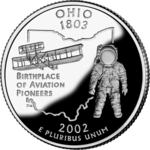 | Wright Flyer III (built by the Wright Brothers who were from Dayton); astronaut; state outline
Caption: "Birthplace of Aviation Pioneers" | Donna Weaver |
| 18 | Louisiana | May 20, 2002
(April 30, 1812) | 764,204,000 |  | Brown pelican (state bird); trumpet with musical notes, outline of Louisiana Purchase on map of US
Caption: "Louisiana Purchase" | John Mercanti |
| 19 | Indiana | August 2, 2002
(December 11, 1816) | 689,800,000 | 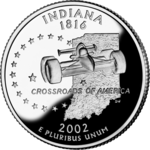 | IndyCar, state outline, 19 stars (representing Indiana as the 19th state to join the Union)
Caption: "Crossroads of America" | Donna Weaver |
| 20 | Mississippi | October 15, 2002
(December 10, 1817) | 579,600,000 |  | Two magnolia blossoms (state flower)
Caption: "The Magnolia State" | Donna Weaver |
| 2003 | 21 | Illinois | January 2, 2003
(December 3, 1818) | 463,200,000 |  | Young Abraham Lincoln; farm scene; Chicago skyline; state outline; 21 stars, 11 on left edge and 10 on right
Captions: "Land of Lincoln;" "21st state/century" | Donna Weaver |
| 22 | Alabama | March 17, 2003
(December 14, 1819) | 457,400,000 |  | Helen Keller, seated, longleaf pine (state tree) branch, magnolia blossoms
Banner with text: "Spirit of Courage"
Caption: "Helen Keller" in standard print and Braille | Norman E. Nemeth |
| 23 | Maine | June 2, 2003
(March 15, 1820) | 448,800,000 |  | Pemaquid Point Lighthouse; the schooner Victory Chimes [17] at sea | Donna Weaver |
| 24 | Missouri | August 4, 2003
(August 10, 1821) | 453,200,000 |  | Gateway Arch, Lewis and Clark and York [18] returning down Missouri River
Caption: "Corps of Discovery 1804–2004" | Alfred Maletsky |
| 25 | Arkansas | October 20, 2003
(June 15, 1836) | 457,800,000 | 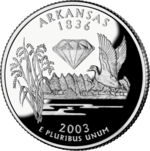 | Diamond (state gem), rice stalks, mallard flying above a lake | John Mercanti |
| 2004 | 26 | Michigan | January 26, 2004
(January 26, 1837) | 459,600,000 |  | State outline, outline of Great Lakes system
Caption: "Great Lakes State" | Donna Weaver |
| 27 | Florida | March 29, 2004
(March 3, 1845) | 481,800,000 |  | Spanish galleon, Sabal palmetto (state tree), Space Shuttle
Caption: "Gateway to Discovery" | T. James Ferrell |
| 28 | Texas | June 1, 2004
(December 29, 1845) | 541,800,000 | 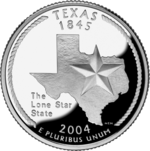 | State outline, star, lariat
Caption: "The Lone Star State" | Norman E. Nemeth |
| 29 | Iowa | August 30, 2004
(December 28, 1846) | 465,200,000 |  | Schoolhouse, teacher and students planting a tree; based on the Grant Wood painting Arbor Day [19] [20]
Captions: "Foundation in Education", "Grant Wood" | John Mercanti |
| 30 | Wisconsin | October 25, 2004
(May 29, 1848) | 453,200,000 | 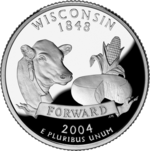 | Head of a cow, round of cheese and ear of corn (state grain).
Banner with text: "Forward" | Alfred Maletsky |
| 2005 | 31 | California | January 31, 2005
(September 9, 1850) | 520,400,000 | 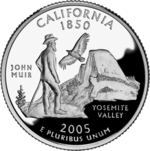 | John Muir, California condor, Half Dome
Captions: "John Muir," "Yosemite Valley" | Don Everhart |
| 32 | Minnesota | April 4, 2005
(May 11, 1858) | 488,000,000 |  | Common loon (state bird), fishing, state outline
Caption: "Land of 10,000 Lakes" | Charles L. Vickers |
| 33 | Oregon | June 6, 2005
(February 14, 1859) | 720,200,000 | 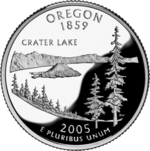 | Crater Lake National Park
Caption: "Crater Lake" | Donna Weaver |
| 34 | Kansas | August 29, 2005
(January 29, 1861) | 563,400,000 |  | American bison (state mammal), sunflowers (state flower) | Norman E. Nemeth |
| 35 | West Virginia | October 14, 2005
(June 20, 1863) | 721,600,000 |  | New River Gorge Bridge
Caption: "New River Gorge" | John Mercanti |
| 2006 | 36 | Nevada | January 31, 2006
(October 31, 1864) | 589,800,000 | 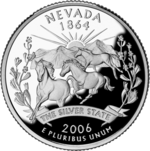 | Mustangs, mountains, rising sun, sagebrush (state flower)
Banner with text: "The Silver State" | Don Everhart |
| 37 | Nebraska | April 3, 2006
(March 1, 1867) | 594,400,000 | 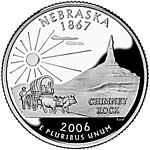 | Chimney Rock National Historic Site, Conestoga wagon
Caption: "Chimney Rock" | Charles L. Vickers |
| 38 | Colorado | June 14, 2006
(August 1, 1876) | 569,000,000 |  | Longs Peak
Banner with text: "Colorful Colorado" | Norman E. Nemeth |
| 39 | North Dakota | August 28, 2006
(November 2, 1889) | 664,800,000 |  | American bison, badlands | Donna Weaver |
| 40 | South Dakota | November 6, 2006
(November 2, 1889) | 510,800,000 |  | Mount Rushmore, ring-necked pheasant (state bird), wheat (state grass) | John Mercanti |
| 2007 | 41 | Montana | January 29, 2007
(November 8, 1889) | 513,240,000 | 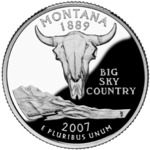 | American bison skull in the center with mountains and the Missouri River in the background.
Caption: "Big Sky Country" | Don Everhart |
| 42 | Washington | April 2, 2007
(November 11, 1889) | 545,200,000 |  | Salmon leaping in front of Mount Rainier
Caption: "The Evergreen State" | Charles L. Vickers |
| 43 | Idaho | June 4, 2007 [21]
(July 3, 1890) | 581,400,000 |  | Peregrine falcon, state outline with star indicating location of state capital Boise, Idaho
Caption: "Esto Perpetua" | Don Everhart |
| 44 | Wyoming | September 4, 2007
(July 10, 1890) | 564,400,000 |  | Bucking Horse and Rider
Caption: "The Equality State" | Norman E. Nemeth |
| 45 | Utah | November 5, 2007
(January 4, 1896) | 508,200,000 |  | Golden spike, Locomotives Jupiter , No. 119 , and the completion of the Transcontinental Railroad
Caption: "Crossroads of the West" | Joseph F. Menna |
| 2008 | 46 | Oklahoma | January 28, 2008
(November 16, 1907) | 416,600,000 | 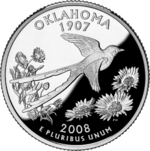 | Scissor-tailed flycatcher (state bird), with Indian blankets (state wildflower) in background | Phebe Hemphill |
| 47 | New Mexico | April 7, 2008
(January 6, 1912) | 488,600,000 |  | State outline with relief, Zia sun symbol from flag
Caption: "Land of Enchantment" | Don Everhart |
| 48 | Arizona | June 2, 2008
(February 14, 1912) | 509,600,000 | 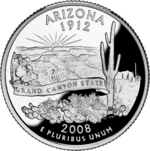 | Grand Canyon, saguaro cactus closeup.
Banner with text: "Grand Canyon State" | Joseph F. Menna |
| 49 | Alaska | August 25, 2008
(January 3, 1959) | 505,800,000 |  | Grizzly bear with salmon (state fish) and North Star
Caption: "The Great Land" | Charles L. Vickers |
| 50 | Hawaii | November 3, 2008
(August 21, 1959) | 517,600,000 |  | Statue of Kamehameha I with state outline and motto
Caption: "Ua Mau ke Ea o ka ʻĀina i ka Pono" | Don Everhart |
